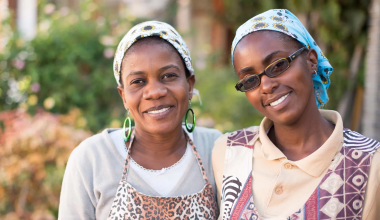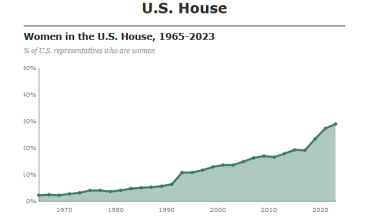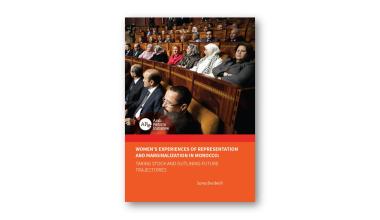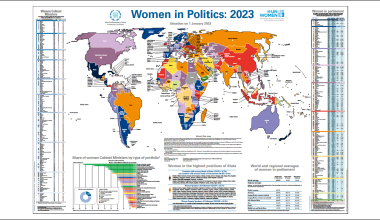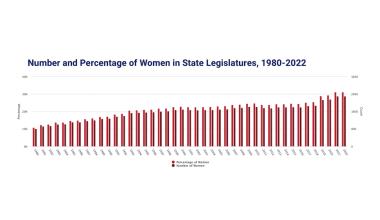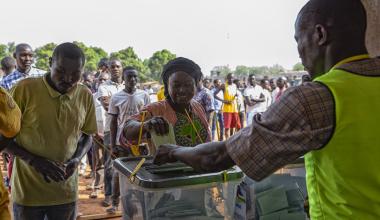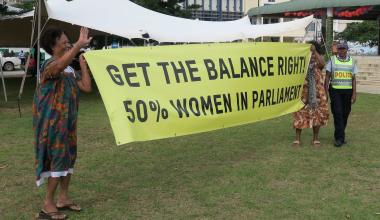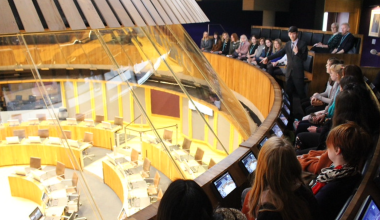Parliaments & Representatives
Main navigation
A Glimpse into the Life of a Women in Politics: CEMR Unveils First Data Coming from 31 Countries
The Council of European Municipalities and Regions (CEMR) has released the first infographics showcasing critical insights from their latest report, "Women in Politics."
The data offer a visual snapshot of the representation of women in elected roles across various subnational levels. Additionally, a detailed breakdown of their portfolios at the local level is provided. The second slide of the infographics unveils the results of an anonymous CEMR survey involving 2,424 participants from 31 countries. Focused on elected women in local and regional European roles, the survey explores their experiences of violence in the political realm.
Click here to see the infographic published by the Council of European Municipalities and Regions on 14 December 2023.
Image by Council of European Municipalities and Regions
.
Normal
0
false
false
false
EN-US
X-NONE
X-NONE
DefSemiHidden="false" DefQFormat="false" DefPriority="99"
LatentStyleCount="376">
UnhideWhenUsed="true" QFormat="true" Name="heading 2"/>
UnhideWhenUsed="true" QFormat="true" Name="heading 3"/>
UnhideWhenUsed="true" QFormat="true" Name="heading 4"/>
UnhideWhenUsed="true" QFormat="true" Name="heading 5"/>
UnhideWhenUsed="true" QFormat="true" Name="heading 6"/>
UnhideWhenUsed="true" QFormat="true" Name="heading 7"/>
UnhideWhenUsed="true" QFormat="true" Name="heading 8"/>
UnhideWhenUsed="true" QFormat="true" Name="heading 9"/>
Name="index 1"/>
Name="index 2"/>
Name="index 3"/>
Name="index 4"/>
Name="index 5"/>
Name="index 6"/>
Name="index 7"/>
Name="index 8"/>
Name="index 9"/>
UnhideWhenUsed="true" Name="toc 1"/>
UnhideWhenUsed="true" Name="toc 2"/>
UnhideWhenUsed="true" Name="toc 3"/>
UnhideWhenUsed="true" Name="toc 4"/>
UnhideWhenUsed="true" Name="toc 5"/>
UnhideWhenUsed="true" Name="toc 6"/>
UnhideWhenUsed="true" Name="toc 7"/>
UnhideWhenUsed="true" Name="toc 8"/>
UnhideWhenUsed="true" Name="toc 9"/>
Name="Normal Indent"/>
Name="footnote text"/>
Name="annotation text"/>
Name="header"/>
Name="footer"/>
Name="index heading"/>
UnhideWhenUsed="true" QFormat="true" Name="caption"/>
Name="table of figures"/>
Name="envelope address"/>
Name="envelope return"/>
Name="footnote reference"/>
Name="annotation reference"/>
Name="line number"/>
Name="page number"/>
Name="endnote reference"/>
Name="endnote text"/>
Name="table of authorities"/>
Name="macro"/>
Name="toa heading"/>
Name="List"/>
Name="List Bullet"/>
Name="List Number"/>
Name="List 2"/>
Name="List 3"/>
Name="List 4"/>
Name="List 5"/>
Name="List Bullet 2"/>
Name="List Bullet 3"/>
Name="List Bullet 4"/>
Name="List Bullet 5"/>
Name="List Number 2"/>
Name="List Number 3"/>
Name="List Number 4"/>
Name="List Number 5"/>
Name="Closing"/>
Name="Signature"/>
UnhideWhenUsed="true" Name="Default Paragraph Font"/>
Name="Body Text"/>
Name="Body Text Indent"/>
Name="List Continue"/>
Name="List Continue 2"/>
Name="List Continue 3"/>
Name="List Continue 4"/>
Name="List Continue 5"/>
Name="Message Header"/>
Name="Salutation"/>
Name="Date"/>
Name="Body Text First Indent"/>
Name="Body Text First Indent 2"/>
Name="Note Heading"/>
Name="Body Text 2"/>
Name="Body Text 3"/>
Name="Body Text Indent 2"/>
Name="Body Text Indent 3"/>
Name="Block Text"/>
Name="Hyperlink"/>
Name="FollowedHyperlink"/>
Name="Document Map"/>
Name="Plain Text"/>
Name="E-mail Signature"/>
Name="HTML Top of Form"/>
Name="HTML Bottom of Form"/>
Name="Normal (Web)"/>
Name="HTML Acronym"/>
Name="HTML Address"/>
Name="HTML Cite"/>
Name="HTML Code"/>
Name="HTML Definition"/>
Name="HTML Keyboard"/>
Name="HTML Preformatted"/>
Name="HTML Sample"/>
Name="HTML Typewriter"/>
Name="HTML Variable"/>
Name="Normal Table"/>
Name="annotation subject"/>
Name="No List"/>
Name="Outline List 1"/>
Name="Outline List 2"/>
Name="Outline List 3"/>
Name="Table Simple 1"/>
Name="Table Simple 2"/>
Name="Table Simple 3"/>
Name="Table Classic 1"/>
Name="Table Classic 2"/>
Name="Table Classic 3"/>
Name="Table Classic 4"/>
Name="Table Colorful 1"/>
Name="Table Colorful 2"/>
Name="Table Colorful 3"/>
Name="Table Columns 1"/>
Name="Table Columns 2"/>
Name="Table Columns 3"/>
Name="Table Columns 4"/>
Name="Table Columns 5"/>
Name="Table Grid 1"/>
Name="Table Grid 2"/>
Name="Table Grid 3"/>
Name="Table Grid 4"/>
Name="Table Grid 5"/>
Name="Table Grid 6"/>
Name="Table Grid 7"/>
Name="Table Grid 8"/>
Name="Table List 1"/>
Name="Table List 2"/>
Name="Table List 3"/>
Name="Table List 4"/>
Name="Table List 5"/>
Name="Table List 6"/>
Name="Table List 7"/>
Name="Table List 8"/>
Name="Table 3D effects 1"/>
Name="Table 3D effects 2"/>
Name="Table 3D effects 3"/>
Name="Table Contemporary"/>
Name="Table Elegant"/>
Name="Table Professional"/>
Name="Table Subtle 1"/>
Name="Table Subtle 2"/>
Name="Table Web 1"/>
Name="Table Web 2"/>
Name="Table Web 3"/>
Name="Balloon Text"/>
Name="Table Theme"/>
Name="List Paragraph"/>
Name="Intense Quote"/>
Name="Subtle Emphasis"/>
Name="Intense Emphasis"/>
Name="Subtle Reference"/>
Name="Intense Reference"/>
UnhideWhenUsed="true" Name="Bibliography"/>
UnhideWhenUsed="true" QFormat="true" Name="TOC Heading"/>
Name="Grid Table 1 Light Accent 1"/>
Name="Grid Table 6 Colorful Accent 1"/>
Name="Grid Table 7 Colorful Accent 1"/>
Name="Grid Table 1 Light Accent 2"/>
Name="Grid Table 6 Colorful Accent 2"/>
Name="Grid Table 7 Colorful Accent 2"/>
Name="Grid Table 1 Light Accent 3"/>
Name="Grid Table 6 Colorful Accent 3"/>
Name="Grid Table 7 Colorful Accent 3"/>
Name="Grid Table 1 Light Accent 4"/>
Name="Grid Table 6 Colorful Accent 4"/>
Name="Grid Table 7 Colorful Accent 4"/>
Name="Grid Table 1 Light Accent 5"/>
Name="Grid Table 6 Colorful Accent 5"/>
Name="Grid Table 7 Colorful Accent 5"/>
Name="Grid Table 1 Light Accent 6"/>
Name="Grid Table 6 Colorful Accent 6"/>
Name="Grid Table 7 Colorful Accent 6"/>
Name="List Table 1 Light Accent 1"/>
Name="List Table 6 Colorful Accent 1"/>
Name="List Table 7 Colorful Accent 1"/>
Name="List Table 1 Light Accent 2"/>
Name="List Table 6 Colorful Accent 2"/>
Name="List Table 7 Colorful Accent 2"/>
Name="List Table 1 Light Accent 3"/>
Name="List Table 6 Colorful Accent 3"/>
Name="List Table 7 Colorful Accent 3"/>
Name="List Table 1 Light Accent 4"/>
Name="List Table 6 Colorful Accent 4"/>
Name="List Table 7 Colorful Accent 4"/>
Name="List Table 1 Light Accent 5"/>
Name="List Table 6 Colorful Accent 5"/>
Name="List Table 7 Colorful Accent 5"/>
Name="List Table 1 Light Accent 6"/>
Name="List Table 6 Colorful Accent 6"/>
Name="List Table 7 Colorful Accent 6"/>
Name="Mention"/>
Name="Smart Hyperlink"/>
Name="Hashtag"/>
Name="Unresolved Mention"/>
Name="Smart Link"/>
/* Style Definitions */
table.MsoNormalTable
{mso-style-name:"Table Normal";
mso-tstyle-rowband-size:0;
mso-tstyle-colband-size:0;
mso-style-noshow:yes;
mso-style-priority:99;
mso-style-parent:"";
mso-padding-alt:0in 5.4pt 0in 5.4pt;
mso-para-margin-top:0in;
mso-para-margin-right:0in;
mso-para-margin-bottom:8.0pt;
mso-para-margin-left:0in;
line-height:107%;
mso-pagination:widow-orphan;
font-size:11.0pt;
font-family:"Calibri",sans-serif;
mso-ascii-font-family:Calibri;
mso-ascii-theme-font:minor-latin;
mso-hansi-font-family:Calibri;
mso-hansi-theme-font:minor-latin;
mso-bidi-font-family:"Times New Roman";
mso-bidi-theme-font:minor-bidi;
mso-font-kerning:1.0pt;
mso-ligatures:standardcontextual;}
Women are not only underrepresented as political candidates across the country, they're also underrepresented as donors.
Driving the news: Women donors made up just 29% to 33% of the contributions to general election candidates at statewide and state legislative levels between 2019 and 2022.
That's according to a new report on the "donor gap" from Rutgers' Center for American Women and Politics using data from OpenSecrets.
Click here to read the full article published by Axios on 17 October 2023.
How is the world doing on gender equality? According to the World Economic Forum (WEF), the picture is mixed. The needle is moving in the right direction, according to its latest Global Gender Gap report, but incrementally. At the current rate of progress, the report finds, it will take 131 years to reach full parity. And no country has yet achieved full gender equality.
Click here to read the full article published by the BBC News on 28 September 2023.
As women’s representation in U.S. politics has grown, 53% of Americans say there are still too few women in high political office in the United States, and many see significant obstacles for women candidates. Our 2023 report on women leaders in politics explores Americans’ views about gender and political leadership, as well as views about the barriers women face.
Click here to read the full article published by the Pew Research Center on 27 September 2023.
In both politics and public life in the UK, women have historically been underrepresented. In recent years women’s representation has increased, although in most cases men remain overrepresented, especially in more senior positions.
This briefing presents statistics on a range of positions in UK politics and public life held by women. Data on the demographic characteristics of different workforces tends to be limited, so it is not always possible to include intersectional analysis, for example, on disabled women or women from minority ethnic groups.
Click here to access the report.
Introduction
The trajectories of and challenges to women’s political participation in Morocco are complex. This complexity can be better understood by unpacking three dimensions for the analysis: the legal reforms, party structures, and women’s individual experiences.
Since the 2002 legislative elections, the antinomic evolution of women's political participation in Morocco has challenged researchers in the political field. We speak of antinomy in the sense that this observation is recorded at the numerical level and is accompanied by a decline in the effective representation of women in decision-making positions. The different governments that have alternated over Morocco since have introduced a series of reforms and measures aiming at encouraging women's political participation, notably the integration of the principle of positive discrimination, better known as the quota system.
Click here to read the paper published by the Arab Reform Initiative on 6 April 2023.
The “Women in politics: 2023” map, created by the Inter-Parliamentary Union (IPU) and UN Women, presents new data for women in executive positions and national parliaments as of 1 January 2023. Data show that women are underrepresented at all levels of decision-making worldwide and that achieving gender parity in political life is far off.
Women serve as Heads of State and/or Government in only 31 countries. Women make up 26.5 per cent of Members of Parliament. Globally, less than one in four Cabinet Ministers is a woman (22.8 per cent). New data show that women lead important human rights, gender equality, and social protection policy portfolios, while men dominate policy areas like defence and economy.
Source: UN Women
In the 2020 elections in Georgia, women increased their share of seats in parliament from 14 to almost 20 percent.
This was the highest it had ever been. But it is not enough, say two MPs, Ana Natsvlishvili from the opposition party, Lelo, and Nino Tsilosani from the ruling party, Georgian Dream.
Both women acknowledge the role of gender quotas, introduced in the last parliamentary (2020) and local elections (2021), in breaking the decades-long underrepresentation of women. “If it wasn’t for gender quotas, political parties would not have put talented and competent women on electoral lists,” says Natsvlishvili.
Tsilosani says women’s political participation is linked to their economic empowerment. “Sixty percent of Georgian women are left outside the formal labour market. This means that they are neither employed nor looking for a job. Imagine what a gain it would be for the economy if we could get them to employment and economic activity. We must offer women services and support to help them become active and contribute to the country’s economic growth.”
Click here to read the full article published by UNDP on 29 June 2022.
Number and Percentage of Women in State Legislatures, 1980-2022
[[{"fid":"20338","view_mode":"media_original","fields":{"format":"media_original","field_file_image_alt_text[und][0][value]":"Number and Percentage of Women in State Legislatures, 1980-2022","field_file_image_title_text[und][0][value]":"Number and Percentage of Women in State Legislatures, 1980-2022"},"link_text":null,"type":"media","field_deltas":{"2":{"format":"media_original","field_file_image_alt_text[und][0][value]":"Number and Percentage of Women in State Legislatures, 1980-2022","field_file_image_title_text[und][0][value]":"Number and Percentage of Women in State Legislatures, 1980-2022"}},"attributes":{"alt":"Number and Percentage of Women in State Legislatures, 1980-2022","title":"Number and Percentage of Women in State Legislatures, 1980-2022","class":"media-element file-media-original","data-delta":"2"}}]]
Current State Legislature
2,300
(1,516D, 764R, 13NP, 5Ind, 2Prg)
31.2% of 7,383 seats
Since 1971, the number of women serving in state legislatures has more than quintupled.
NP = non-partisan, Ind = Independent, Prg = Progressive
State-by-State Summary Data on Current Women State Legislators
Click here to access the data.
How does the gender composition of the Australian parliament compare with parliaments around the world, and how has it changed over the past two decades
International comparisons
The Inter-Parliamentary Union (IPU) has published international rankings of women in national parliaments since 1997. The IPU’s rankings are based on the representation of women in the lower (or single) houses of national parliaments only. The representation of women in the Australian Senate is therefore not factored into Australia’s ranking.
As illustrated in Figure 1 below, Australia’s IPU ranking for women in national parliaments was 27th in 1997, rising to 15th in 1999. In 2022 Australia’s ranking has fallen to 57th.
Click here to read the full article published by Parliament of Australia on 20 April 2022.
Data provided by the Center for American Women and Politics and KnowWho Data Services. Numbers include members and officers of the municipal legislative branch of incorporated cities and towns with populations over 10,000 as per the U.S. Census. These bodies vary by municipality, but include city councils, boards of alderman, city commissions, among others. Mayors and other officials who perform mayoral functions are included in these counts. Data is as of March 2022 and will be updated annually.
Click here to access the data.
A survey on politicians in Japan has shown that many former and current female national legislators and local assembly members have been subject to sexual harassment.
"I was threatened that if I did not kiss them, they would not vote for me," and "I was told that young women win elections even if they are not qualified," are examples of some of the responses.
Released in February, the results were a part of a "politician harassment white paper" containing the results of a survey carried out by Tokyo-based Woman Shift, a network of young female lawmakers and assembly members, as well as Polilion, a Gifu Prefecture-based organization that conducts harassment training for legislatures and assemblies. The survey was carried out between August and October 2021, and 200 people (100 men, 98 women and 2 others) responded.
Click here to read the full article published by The Mainichi on 29 March 2022.
In celebration of International Women's Day, we review the history of women in politics in Mexico. Gender parity electoral laws, leaders who value women's inclusion, and fierce women who have propelled Mexico's gender equality movement forward have altogether helped realize the major strides in women's representation, especially since the turn of the century. Women have not only vied for more elected positions; they have also secured a historic number of governorships and legislative seats, effectively reaching gender parity in Congress. President Lopez Obrador has also made a point to promote women to appointed positions, both in his cabinet and in the Supreme Court. While Mexico still has a way to go in reaching full gender equality and equity, gender quotas have had the positive effect of normalizing women's active role in politics and of welcoming them as viable and worthy contenders in the political arena, moving the needle in a necessary and positive direction.
Click here to read the full article published by The Wilson Center on 7 March 2022.
Today’s parliament has more female MPs than ever but they remain a minority. What do they think is needed for equality in the corridors of power?
Viscountess Nancy Astor was the first woman to take a seat in parliament, receiving 2,000 letters a week from female voters desperate to finally have their voices heard.
More than 100 years later, women account for just a third of seats in the Commons and only a quarter of sitting peers in the House of Lords.
Click here to read the full article published by The Times on 8 March 2022.
Sitting at her desk with the Central African flag behind her, Beatrice Epaye’s sustained gaze hints at courage and determination. And she has both in quantities. While running for a parliamentary seat in the December 2020 election, she recalls the many physical and verbal attacks and threats she faced as a woman.
“It is our right to sit at the decision-making tables, not just around them. Last elections showed us that we still have a long way to go,” she nods. “Many more women [than men] are attacked during an election campaign,” says the MP and women’s rights advocate.
Violence against women is clearly a deterrent to their involvement in politics, pushing many of them out of political activities and muting their voices. According to an Expert Group Meeting from 2018, 44.4 percent of women in politics surveyed across 39 countries in 2016 reported having received threats of death, rape, assault, or abduction. One fifth said they had been subjected to sexual violence. But the severity of this matter is perhaps greater as violence against women tends to be under-reported, and crimes unpunished.
Click here to read the full article published by UN Peacekeeping on 13 December 2021.
But what is far too often the exception should become the norm.
“A country without a woman MP is not a democratic country”, declared Dame Carol Kidu, Papua New Guinea’s former – and only female – opposition leader, this month.
Dame Carol’s comment refers to the current state of politics in PNG, a democracy, where only seven women have ever been elected to its parliament. Dame Carol is one of them. She had a long, successful career there (1997–2012) including being the only woman and Minister for Community Development for much of her tenure. Preceding Dame Carol were the founding women: Dame Josephine Abaijah, the first woman elected to PNG’s Parliament (1972–82), Nahau Rooney (1977–87), and Waliyato Clowes (1977–82).
Click here to read the full article published by The Interpreter on 18 February 2022.
Every decision a parliamentarian makes is a chance to advance gender equality. From choosing a topic for an oversight inquiry to drafting legislative amendments, gender-sensitive scrutiny can help bring inequalities to the surface and find remedies.
The idea of a ‘gender-sensitive parliament’ has evolved over time. A new definition was recently coined: “A gender-sensitive parliament values and prioritises gender equality as a social, economic and political objective, and reorients and transforms a parliament’s institutional culture, practices, and outputs towards these objectives.”
Click here to read the full article published by Chwaraeteg on 9 February 2022.
By Akshi Chawla
As women elected officials move from local politics towards the subnational and national levels, they begin to be replaced by more and more men.
Women comprise just over one-third (36 percent) of the over 6 million elected members in deliberative bodies of local governments globally, according to a new working paper released by U.N. Women last month. Although far from parity, this is the best representation women seem to get across levels of government: As they move towards the subnational and national levels, they begin to be replaced by more and more men, data shows.
Click here to read the full article published by Ms Magazine on 15 February 2022.
Political decisions get better the more diverse the people are who make them. That is especially true in deeply divided societies, in countries that want to move from war to peace. Yet, women and marginalised groups are often absent from tables where key decisions are made. The same applies to our own EU and national institutions. Foreign and security policy often remains a closed circle of “people with badges talking to people with badges”. And the higher the level, the “harder” the security, the fewer women. This shouldn’t be news, but it is important to have data on the subject matter to push for real change. And that is why I set out, in 2020, to build the #SHEcurity Index; together with a growing team of supporting organisations and individuals.
This is the 2nd edition of the #SHEcurity Index. The index for the first time gave a comprehensive overview of how far we have come with regards to gender equality in Peace & Security and UN resolution 1325.
Click here to read the full report published by SHEcurity.
In 2011, the Arab Spring precipitated fervent calls for democratic reforms, leading the Moroccan government to enact gender quotas that reserved seats for women in Parliament as well as regional, district, and communal councils. As a result of these new electoral laws, Moroccan voters elected an unprecedented number of women to legislatures at all levels of government, from local councils to the House of Representatives.
Gender quotas have successfully increased the descriptive, or numerical, inclusion of women in Moroccan government. It is not immediately clear, however, how these gains in women’s descriptive representation have affected women’s substantive representation—the representation of their policy preferences and priorities.
This article examines whether extensive gender quota provisions in Morocco have meaningfully contributed to women’s political inclusion.
What are Gender Quotas?
Gender quotas are an affirmative action measure designed to address the underrepresentation of women in politics. They were originally adopted by political parties in Norway during the 1970s, and they have since become one of the fastest-growing legal trends spreading to different regions of the world and different political contexts. Today, 132 countries have implemented some kind of quota for women.
Click here to read the full article published by the Georgetown Institute for Women, Peace and Security on 21 July 2021.
Black women in politics face a harrowing reality: Harassment, abuse and death threats for doing their jobs as Black women. To better understand their experiences, the PBS NewsHour requested interviews with more than 61 Black women who have held office or run for office at various levels of government and across the political spectrum Eighteen women, 16 of them Democrats, shared their stories. Here’s what they described.
Black women are harassed differently than their white or male colleagues. Moya Bailey of Northeastern University coined the term “misogynoir” to describe the anti-Black misogyny that Black women face. Women in public-facing roles are more likely to receive physical threats, said Mary Anne Franks, a professor at the University of Miami’s School of Law, and these threats often are charged with racism and sexism.
Black women largely see racism and misogyny on the job as an unchangeable reality. The majority of the women interviewed by the NewsHour experienced some form of racist or sexist targeted hate while serving in or running for office at various levels of government, from school board races to Congress. Several of the women NewsHour interviewed commented that the harassment they experienced, though shocking in its aggressiveness and vulgarity, was something they had ultimately come to expect as “part of the job.” Some said they were discouraged — either by colleagues or people in their personal lives — from speaking publicly about the harassment they face.
Click here to read the full article published by PBS on 29 June 2021.
Development of local or regional caucus for women councillors – identifying interest and examining possible supports.
Women’s caucuses have been established in political institutions around the world to strengthen cross-party cooperation among women politicians and to enhance the recruitment of new women candidates. Drawing on extensive research with women councillors and other key stakeholders, this report offers a pathway for the establishment of local or regional caucuses in local government in Ireland and makes recommendations to local authorities and the Department of Housing, Planning and Local Government in relation to maximising supports. Importantly, the research also documents the opportunities and challenges experienced so far by established caucuses in Limerick and Dublin City and explores related cross-party initiatives for women councillors that have taken place at regional and national level. This research was kindly supported by the Department of Housing, Planning and Local Government.
Source: National Women’s Council
Mexico is the first country in the world to implement gender parity so thoroughly and effectively. The journey has not been easy—and is far from over.
In 2018, women won half the seats in Mexico’s Congress. They then championed a groundbreaking constitutional reform: gender parity for all candidates for elected office, and for top posts in the executive and judicial branches. Called “parity in everything,” the reform sailed to victory in May 2019. Not a single member of Congress voted against it.
This easy success seems astounding, but parity in everything capped a decades-long process of increasing Mexican women’s access to political power. By 2019, political parties already respected 50–50 rules when nominating candidates for the federal Congress, the state legislatures, and the municipal governments, including mayors. The last holdout among elected positions were coveted governor positions. Only seven of Mexico’s 32 states have ever elected a woman governor: That’s seven women compared to 344 men since Mexican women gained the right to vote in 1953.
Feminists hope that number changes on June 6, 2021, when Mexico holds midterm elections and gender parity applies to gubernatorial nominees for the first time. Other newly-implemented rules further tilt the electoral playing field in women’s favor, and not just in the governor races. Those convicted of violence against women cannot stand for elected office. And of the campaign resources that parties distribute to candidates, 40 percent of the money and 40 percent of the advertising time must go to women.
Click here to read the full article published by MS Magazine on 4 June 2021.
There are few women in political and leadership spaces in Nigeria. Currently only seven out of 109 senators and 22 of the 360 House of Representatives members are women. Ogechi Ekeanyanwu, from The Conversation Africa, asked Damilola Agbalojobi, political scientist and gender specialist, to explain the lack of representation, why it matters and how to remedy it.
Why are women so poorly represented in leadership positions?
There are multiple factors. Some are related to the political party systems and structures. For instance, the high cost of politics prevents women from standing for positions. Often women don’t have enough money to pay for the mandatory expression of interest and nomination forms required by political parties to run for positions on their platforms. In addition, election campaign costs are exorbitant. So poor access to education means poor access to gainful employment. Unpaid labour burdens, unequal inheritance rights and outright discrimination also mean that women are less likely to be able to afford to follow through the process of getting leadership position.
Click here to read the full article published by The Conversation on 3 May 2021.


